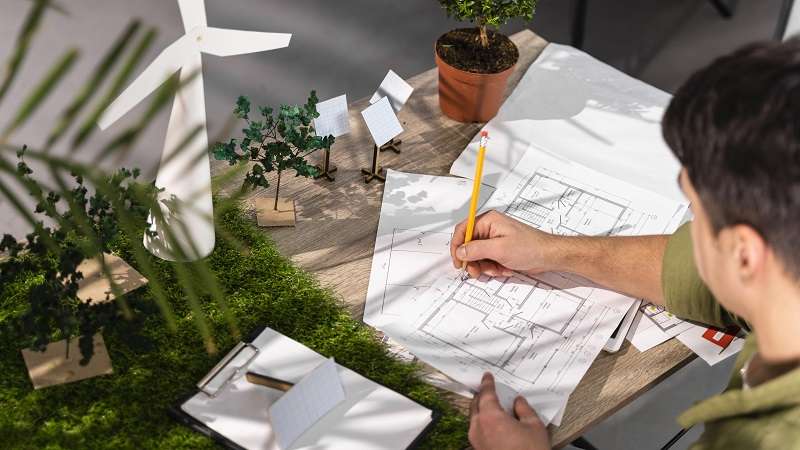Creating a home that feels both welcoming and practical doesn’t stop at the front door. Your outdoor space is just as important as the interior, and when designed thoughtfully, it can enhance curb appeal, boost property value, and provide a peaceful retreat. The key is balancing beauty with functionality, ensuring your landscape design is both aesthetically pleasing and easy to maintain.
In this guide, we’ll explore how to build a beautiful & functional landscape – home maintenance checklist that helps you plan, design, and care for your outdoor areas season after season.
Why Landscaping Matters in Home Maintenance
Landscaping isn’t just about planting flowers. It’s about creating harmony between nature and architecture, while ensuring the space is usable and sustainable. A functional landscape:
-
Enhances property value by up to 15–20%
-
Improves energy efficiency through shade and wind protection
-
Provides outdoor living space for entertainment and relaxation
-
Reduces soil erosion and water waste
By integrating landscaping into your home maintenance checklist, you ensure your outdoor environment works as hard as your indoor systems to keep your property in top shape.
Step 1: Evaluate Your Outdoor Space
Before jumping into planting and hardscaping, assess your yard’s unique characteristics.
-
Soil Quality: Check pH levels and drainage to determine what plants will thrive.
-
Sunlight Exposure: Observe which areas receive full sun, partial shade, or deep shade.
-
Climate Considerations: Choose plants suited to your region’s temperature and rainfall.
-
Existing Structures: Work around driveways, patios, fences, and utility lines.
This evaluation forms the foundation of a functional design plan and helps you avoid costly mistakes.
Step 2: Create a Functional Landscape Design Plan
A good plan makes your landscape both beautiful and easy to maintain.
-
Zoning Your Yard: Divide spaces for dining, play, gardening, and relaxation.
-
Traffic Flow: Add pathways with stone, gravel, or pavers to guide movement.
-
Focal Points: Use trees, sculptures, or water features to draw the eye.
-
Balance & Proportion: Match plant sizes and colors with the scale of your home.
When you’re considering how to build a beautiful & functional landscape – home maintenance checklist, design is the roadmap that keeps everything practical and cohesive.
Step 3: Choose Low-Maintenance Plants
Plants can make or break your landscaping efforts. Selecting the right ones saves time and money.
-
Native Plants: They adapt easily and require less watering.
-
Perennials: Long-lasting plants that return every year.
-
Evergreens: Provide year-round greenery and structure.
-
Drought-Resistant Options: Ideal for regions with water restrictions.
By mixing these plant types, you reduce upkeep while keeping your yard visually dynamic.
Step 4: Incorporate Hardscaping for Functionality
Hardscaping elements make your landscape more usable and durable.
-
Patios & Decks: Extend living spaces for gatherings.
-
Walkways: Prevent soil compaction and guide movement.
-
Retaining Walls: Control soil erosion on slopes.
-
Outdoor Lighting: Add safety and ambiance.
Functional hardscaping ties the yard together while minimizing maintenance headaches.
Step 5: Prioritize Irrigation and Drainage
Water is the lifeblood of any landscape, but too much or too little can ruin your design.
-
Install Drip Irrigation: Directs water where it’s needed, reducing waste.
-
Smart Sprinkler Systems: Adjust watering based on weather conditions.
-
Rain Gardens: Capture runoff naturally and add beauty.
-
Proper Grading: Ensure water flows away from the house foundation.
Making irrigation part of your checklist prevents overwatering, plant loss, and costly foundation issues.
Step 6: Add Outdoor Living Features
Landscapes should be enjoyed, not just admired. Adding livable features makes outdoor areas functional.
-
Fire Pits: Create cozy gathering spots.
-
Pergolas & Gazebos: Provide shade and architectural interest.
-
Outdoor Kitchens: Perfect for entertaining.
-
Water Features: Fountains or ponds add tranquility.
These upgrades extend the usability of your yard across seasons.
Step 7: Seasonal Maintenance Checklist for Landscaping
A truly functional landscape requires consistent care. Here’s a quick breakdown by season:
Spring
-
Fertilize lawns and flowerbeds
-
Clean gutters and downspouts
-
Mulch beds to retain moisture
-
Inspect irrigation systems
Summer
-
Mow regularly and water deeply
-
Prune shrubs and hedges
-
Inspect decks and patios for wear
-
Monitor pest activity
Fall
-
Rake leaves and compost them
-
Aerate and seed lawns
-
Trim trees to prevent winter breakage
-
Drain outdoor faucets and hoses
Winter
-
Protect plants with burlap or covers
-
Clear snow from pathways and driveways
-
Store outdoor furniture
-
Check for ice damage around hardscapes
Keeping this seasonal cycle ensures your landscape stays both beautiful and manageable year-round.
Step 8: Eco-Friendly Landscaping Practices
Sustainability should be part of every homeowner’s landscape plan.
-
Composting: Turn yard waste into nutrient-rich soil.
-
Rain Barrels: Collect and reuse rainwater for irrigation.
-
Solar Lighting: Save energy while illuminating pathways.
-
Pollinator Gardens: Support bees, butterflies, and birds.
These practices protect the environment while lowering maintenance costs.
Step 9: Budgeting for Landscaping and Upkeep
Landscaping doesn’t need to drain your wallet if planned carefully.
-
DIY Projects: Handle planting, mulching, or small features yourself.
-
Hire Professionals for Complex Work: Retaining walls, grading, or electrical lighting.
-
Plan in Phases: Spread out expenses across months or seasons.
-
Track Ongoing Costs: Water, fertilizer, and seasonal tools.
Budgeting helps you stay realistic while still achieving your dream landscape.
Long-Term Benefits of a Functional Landscape
When designed and maintained properly, your outdoor space becomes an investment rather than a burden.
-
Increased Home Value: Buyers are drawn to well-kept landscapes.
-
Energy Savings: Strategic planting reduces heating and cooling costs.
-
Improved Lifestyle: Outdoor living enhances relaxation and family bonding.
-
Lower Maintenance Stress: Smart planning means less upkeep over time.
Incorporating landscaping into your home maintenance checklist ensures you reap these benefits for years to come.
Final Thoughts
A landscape that blends beauty with functionality doesn’t happen overnight, but with the right plan and consistent care, it becomes a long-term asset. By evaluating your space, selecting the right plants, integrating hardscaping, and following seasonal maintenance, you can create an outdoor environment that complements your home and lifestyle.
Remember: How to Build a Beautiful & Functional Landscape – Home Maintenance Checklist isn’t just about looks—it’s about creating a sustainable, safe, and enjoyable space that works for you year after year.

